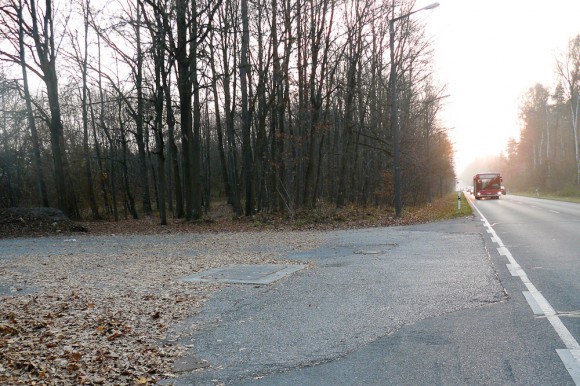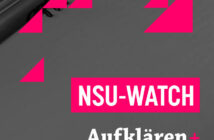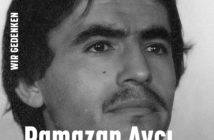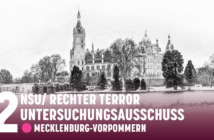Often overlooked by international media, the trial of five German Neo-Nazis has revealed a disturbing level of state support for the organizations of the violent far right and raised fundamental questions about the state’s ability to protect immigrant communities from racially-motivated terrorism.
An article by Friedrich Burschel, translated by Loren Balhorn.

Here started the murder series of the NSU: on the Liegnitzer Street in Nuremburg-Langwasser. Enver Şimşek (39 years old) run a small flower shop on this busy street near the edge of the city when he was shot down. He died two days later on September 11th, 2000. (Foto: Birgit Mair)
Enver Şimşek, 38 years old, ran a large flower distribution center in the southern German city of Nuremberg. On this particular day in the late summer of 2000, he found himself working at a small flower shop on a busy street near the edge of the city, sitting in for a worker on vacation. After setting up the shop, the practicing Muslim paused to recite a morning prayer, withdrawing to the back of his white delivery van labelled “Blumen Şimşek” to do so. Suddenly, two men in bicycling outfits approach the van by foot, throw open its doors and open fire on Enver, before slamming them shut and disappearing on bicycles stashed nearby. Eventually, waiting customers begin to wonder what happened to the flower shop’s attendant and call the police, who promptly discover Enver, still clinging to life in the back of the van, shot eight times in the head and torso. Enver Şimşek would die from his injuries two days later on September 11th, 2000, leaving behind a wife and two children aged 13 and 14.
Şimşek was the first victim of a series of murders and bombing attacks that puzzled German authorities for 11 years, not least because potential racist or political motives were systematically ignored, despite the fact that nine of the ten murders were carried out with a Česká 83 pistol and that the first nine victims were all of Turkish or Kurdish backgrounds, in addition to one Greek small businessman. Less than one year later, on June 13th, 2001, 49-year old Nuremberg tailor Abdurrahim Özüdoğru would meet a similar fate, as would grocer Süleyman Taşköprü (31) in Hamburg on June 27th and Munich shopowner Habil Kılıç (38) on August 29th. All three were murdered, shot in the head with a Česká 83. Following a noticeable two-and-a-half-year pause, the Česká 83 reemerged in the coastal city of Rostock on February 25th, 2004, implicated in the murder of 25-year old döner kebab seller Mehmet Turgut. The same pistol would go on to kill İsmail Yaşar (50) on June 9th, 2005 – Nuremberg’s third victim. Only six days later, a 41-year old co-owner of a locksmith shop named Theodoros Boulgarides would die in Munich. On April 4th, 2006, 39-year old Mehmet Kubaşık would be shot in Dortmund, and only two days later a 21-year old internet café proprietor named Halit Yozgat would be gunned down in Kassel.
For the victims’ families, the shock of their murders was followed by years of gut-wrenching investigations as suspects in their loved ones’ deaths by German police. The list of clichés and ethnic stereotypes deployed by authorities in their investigation says a lot about the attitudes they harbored towards Turkish immigrants. Police suspected the murderers were related to PKK protection rackets, the Turkish mafia, private debts, gambling addictions, tax dodging and, most often, jealousy and marital disagreements. Enver Şimşek’s wife Adile was shown a picture of a “blonde German woman” by police, telling her it was of her murdered husband’s secret lover with whom he had conceived two children. By doing so, the police hoped to compel Adile, whom they suspected of killing her husband in a fit of jealousy, to admit to the crime. Only much later would the family learn that the story had been fabricated. None of the officials tasked with the investigation considered racist motives to be a potential factor, although multiple individuals interviewed by authorities expressed concerns that a violent racist was on the loose, hunting immigrants. Witness statements from more than one of the murders described two men on bicycles, but police largely ignored this fact. When asked why police did not pursue links to Nazism or the bicyclists, then-chief investigator of the Munich murder commission and popular author Josef Wilfling responded, “Have you ever seen a Nazi on a bike?”
Police in Nuremberg went so far as to open up a fake döner kebab shop, hoping that the Turkish mafia would come to collect unpaid protection money. In one instance, police arranged for a psychic claiming to have contacted the victims to be flown in from Iran. Authorities were determined to investigate every possible lead, or at least every lead that confirmed their belief that these sorts of murders were typical in the Turkish immigrant community. The media, a democratic society’s fourth estate responsible for holding the government to account, accepted the police’s racist assumptions uncritically in their reporting, referring to the series of killings as the “Döner Murders”. This racist, stereotype-driven narrative dominated public debate. Despite pleas for help from victims like Envir Şimşek’s 19-year old daughter Semiya, few outside of the Turkish and Kurdish communities listened. The 2,000-strong demonstrations held in Kassel and Dortmund a month after the deaths of Mehmet Kubaşık and Halit Yozgat under the slogan “No Tenth Victim” remained almost exclusively immigrant events. Accordingly, a position paper drafted by the Baden-Württemberg State Office of Criminal Investigations in January 2007 stated: “Given that the killing of human beings is highly taboo within our cultural space, we can safely assume that the perpetrator is, in terms of his behavioral system, located far outside our local system of values and norms.” This treatment went on for years. The friends and family of the victims would finally learn the true identity of their murderers in 2011, albeit not as a result of effective police work, but through the self-incrimination of the murderers themselves.
A motorhome in the Thuringian city of Eisenach burst into flames on November 4th, 2011. Inside, the charred remains of two bodies were found, both of which clearly had suffered violent deaths before the fire. Hours later an apartment explodes and burns to the ground in Zwickau, 200km away in Saxony. A series of revelations would rock the country over the following days: the corpses in the motorhome belonged to Uwe Mundlos and Uwe Böhnhardt, and the apartment had been blown up by Beate Zschäpe, who turned herself in four days later. The three allegedly constituted the core of a Neo-Nazi terrorist cell named the “National Socialist Underground” (NSU), committing nine racially-motivated murders and killing a police officer (while severely injuring another) between 1998 and 2011. The group also committed at least three bombing attacks, including exploding a nail bomb in Cologne on June 9th, 2004, and robbed at least 15 banks and businesses. Before turning herself in, Szschäpe distributed a series of bizarre and disturbing propaganda videos claiming responsibility for the killings to the media, government institutions and even leftist and anti-fascist organizations on November 4th.
But even more sensational and disturbing than the NSU and its hundreds of behind-the-scenes supporters were the levels of state involvement in the terrorist circle, constituting the biggest scandal in the history of the post-war German intelligence services. The precise extent of state involvement remains unclear to this day. Authorities implicated in the NSU affair (police, the so-called “Federal Office for the Protection of the Constitution”, the foreign intelligence service, military counter-intelligence, etc.) have conducted an unprecedented cover up, obstructing the investigative work of 11 parliamentary commissions on both federal and state level and the NSU trial itself, currently being held at the Munich higher court (one level below Germany’s supreme court). The state has actively withheld and manipulated information and destroyed countless documents to prohibit a proper investigation into the workings of intelligence service operatives and their informants. Many questions remain unanswered, and the state’s version of events is still riddled with inconsistencies.
More or less agreed upon is the history of the perpetrators and the emergence of the terror cell and its nation-wide support network itself, as these details have dominated the court’s investigation thus far. Although a total of 77 co-plaintiffs represented by over 50 lawyers are involved in the trial – also unprecedented for the German legal system – their demand for a thorough investigation of state involvement in the murders is rarely taken into consideration. The federal prosecutor’s office, a deeply political institution, has been tasked with helping the state avoid difficult and potentially compromising questions inside the courtroom and throughout the investigation. Since the outset of the trial, the federal prosecutor has done its utmost to prevent probing questions concerning the state’s involvement in and even responsibility for the NSU’s emergence and destructive criminal behavior from coming to the fore. Instead, the trial has largely focused on the five defendants, co-perpetrator Beate Zschäpe and four men accused of “supporting a terrorist association.” The federal prosecutor still claims that the NSU was an “isolated” three-person cell, only supported by a handful of accomplices – a version of events that is hardly supported by the available evidence and widely regarded as false. For example, many of the NSU’s crimes required detailed knowledge of the locality in which they were committed, and could not have occurred without wide-ranging assistance. NSU-Watch, an independent website that publishes critical reporting on the trial, estimates that dozens, if not hundreds, of sympathizers and even accomplices, many of them linked to the Blood & Honour and Hammerskin international Neo-Nazi networks, provided the group with money, weapons, shelter and escape routes over the years.
The life stories of Beate Zschäpe (now 40 years old) and the deceased Uwe Mundlos and Uwe Böhnhardt have been pored over in the course of the investigation. Adolescents in 1989, the three grew up in the east German city of Jena at a time when the old authorities in the GDR (family, school, police) were compromised and powerless, but no new authority had emerged to fill the vacuum. This fed into a wave of racist violence across Germany, albeit primarily in the former East, in the early 1990s, culminating in racist pogroms in Hoyerswerda (Saxony) and Rostock-Lichtenhagen (Mecklenburg-Vorpommern) for which few ever went to prison. The government would ultimately respond to the racist street mob by rewriting the constitution to curtail asylum and immigration rights, giving many participants the impression that their violence against immigrants and asylum-seekers had served to enforce the “will of the people”.
The young Nazis from Jena would radicalize over the coming decade, taking inspiration from American far right groups and keenly reading the classic American Nazi tract The Turner Diaries, which almost everyone implicated in the trial had a PDF copy of on their computer. Like Timothy McVeigh and The Order before them, these German Nazis were drawn to the book’s call for “leaderless resistance”, random violence against perceived racial enemies and an underground, outlaw existence. British Neo-Nazi David Copeland, responsible for a devastating nail bomb attack in London in 1999, had been likewise inspired by the Diaries; the NSU’s own nail bombing in 2004, one of three attacks attributed to the NSU, may quite possibly have been inspired by Copeland.
Another American import, the Ku Klux Klan, also played a role in the development of Neo-Nazi structures in post-reunification Germany. In the early 1990s, KKK hardliner Dennis W. Mahon went on a speaking tour across Germany to recruit young Germans for his “race war”, and would meet Ian Stuart Donaldsen, the founder of Blood & Honour, in Saarland. Suspiciously, several key witnesses concerning the KKK’s influence on far right terror networks in Germany have died under mysterious circumstances, such as state informant and KKK member Thomas Richter, aka “Corelli”, whose death in April 2014 from “severely low blood sugar” remains shrouded in uncertainty to this day. The role of KKK members within the Baden-Württemberg police also remains unclear. For example, the shift leader during the attempted assassination of police officers Michèle Kiesewetter and Martin Arnold was, as it turns out, a KKK member, and incontrovertible evidence shows that FBI s were in immediate proximity to the scene of the crime.
The further back into the group’s history one looks, the deeper the ties between the far right and the state become. In the mid-1990s, state informant Tino Brandt directed large amounts of money from the domestic intelligence services into the Thuringian far right scene, helping to establish the so-called Thüringer Heimatschutz, the group that would incubate Zschäpe, Mundlos and Böhnhardt’s terrorist ambitions before they went on to found the NSU in 1998. The expansion and consolidation of far right networks in Thuringia would have been impossible without the active participation of the domestic intelligence services. Tino Brandt alone received over 100,000 euros during his time as an informant, in addition to technical equipment (cell phones, computers, cars, etc.) and other expenses (hotels, transportation). Independent researchers have concluded that the broader Nazi scene in which the NSU was rooted was packed with state informants, who regularly forwarded details of the terrorist trio’s activities onto domestic intelligence. Most recently, it emerged in early 2016 that an informant from the Office for the Protection of the Constitution named Ralf Marchner, codename “Primus”, employed Uwe Mundlos in his construction firm in Zwickau from 2000-2001, and possibly hired Zschäpe to work in one of the popular Neo-Nazi hangouts he owned as well. Two scenarios seem plausible: either Marchner failed to inform his department head of these developments, which would in turn call the reliability of the entire informant system into question, or the state was well aware of these activities and chose not to intervene, so as to avoid “disturbing” the terrorist cell before gathering sufficient evidence to prosecute them. The series of murders was already under way at this point, and Marschner’s firm also had locations in Munich and Nuremberg – where three of the killings had occurred. Even more alarmingly, Marschner is only one of 24 known state informants working in the east German Nazi scene, although many suspect that up to 40 informants are involved in total.
One of the most bizarre inconsistencies in the NSU affair is the case of intelligence service Andreas Temme, who was in Halit Yozgat’s internet café during his murder in April 2006 and behaved suspiciously afterwards. It remains unclear, even after dozens of interrogations, what exactly happened in Kassel and whether or not Temme had been aware of the deed beforehand, or perhaps even been involved. In a recorded phone call with a colleague a week after the murder, while Temme was already under investigation, a voice can be heard saying “I tell everyone: if I know that something like that is going to happen – please don’t go there!” This sentence can only be understood to mean that Temme or his office knew about Yozgat’s murder before it occurred. Then-Interior Minister for the state of Hesse and current Minister-President Volker Bouffier intervened to suspend the investigation and prevent the interrogation of informants from the Nazi scene – “in the interests of the Hessian state”.
For family and friends of the victims, but also for the trial’s defendants, the extent of the state’s involvement in nurturing right-wing terrorists, and its shared responsibility for the NSU’s deeds – whether by tolerating, facilitating or even encouraging them – remains the central question of the investigation. Unfortunately, it is also the question that has yet to be answered, despite Angela Merkel praising authorities’ “spotless investigation” at the central memorial service for NSU victims on February 23rd, 2012.
In reality, the authorities she praised conducted a major cover up operation just days after the NSU’s existence came to light. On November 11th, 2011, a high-ranking official from the Office for the Protection of the Constitution shredded numerous incriminating documents to protect his office and the identities of his “sources” (that is, informants). Following his example, various regional offices and other state institutions with links to the NSU began doing the same, destroying almost 400 documents and files in total. A former vice-president of the office, testifying in front of a parliamentary commission on the matter, stated categorically: “No state secrets that undermine the government’s ability to act may be allowed to become public.” The domestic intelligence services have thus far managed to emerge from the scandal relatively unscathed, while the Office for the Protection of the Constitution itself could not have asked for a better fundraiser: the agency has more staff, more money and more authority than ever before, although every reason exists to believe that it was implicated in both the murders as well as the bombing attacks. At the very least, the Office knew about the attacks in advance and did nothing to prevent them.
After roughly 300 days of the trial, the victims and their families have mostly given up hope that the the Munich higher court will shed light on what exactly happened over the NSU’s thirteen years of existence. Neither the trial nor the numerous parliamentary commissions convened to investigate the NSU affair will uncover the truth. Aware of this fact, many of those affected by the NSU murders have come together to establish a tribunal “against the Federal Republic of Germany” in order to attract more public attention, uncover the truth and hopefully achieve a modicum of justice – and most importantly, to scandalize the state’s involvement in the affair. The Munich court’s verdict, expected in early 2017, will by no means mark the end of the NSU in German public life, nor of right-wing terror in general. The Federal Criminal Police Office issued a warning concerning the development of further right-wing terrorist groups in early 2016. In light of the hundreds of thousands of refugees who have crossed Germany’s borders since last year, the shoddy investigation into the NSU’s activities also has implications outside of the concrete bunker in which the trial is being conducted. Ultimately, other Neo-Nazi and far right groups will be encouraged by the state’s cover up and its decision to protect the perpetrators, rather than the victims, of racist terror, and may decide to emulate their idols in the future.
Friedrich Burschel works at the Academy for Political Education of the Rosa Luxemburg Foundation in Berlin, with an emphasis on Neo-Nazism and the Structures and Ideologies of Supremacy. He is an accredited observer of the NSU trial for the non-commercial Radio Lotte Weimar and contributes to the NSU-Watch project (www.nsu-watch.info).


